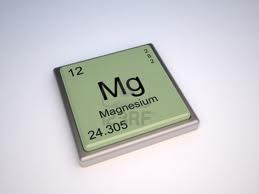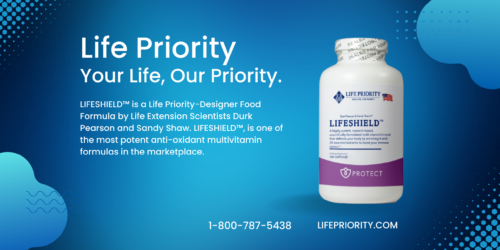
Ring the Bell for Magnesium Priority
- by Life Priority
- No Comments
- Post Views: 91
*Interview with Durk Pearson and Sandy Shaw Regarding the Importance of Magnesium

Epidemiological studies conducted in countries such as Germany, Sweden, South Africa, and Italy strongly suggest that low levels of magnesium in the water supply are associated with coronary heart disease.1-4 Indeed, it is now becoming clear that inadequate levels of magnesium is a problem throughout the Western World, and that a lower than normal dietary intake increases the risk of hypertension, cardiac arrhythmias, ischemic heart disease, arherogenesis and sudden cardiac death.5 Moreover, shortages of serum magnesium often appear to be associated with other cardiovascular problems including coronary vasospasm. The above data has been evident for quite some time.
However, as Durk Pearson & Sandy Shaw point out, there are other reasons for increasing dietary supplementary intake of magnesium beyond the RDA. If you miss the ringing of the magnesium bell and what they have to say in the following exchange, you miss at your own risk.
DURK: For many years it’s been realized that magnesium is important to cardiovascular health and inadequate quantities of magnesium lead to an increased incidence of cardiovascular disease. Unfortunately, many of the most common sources of magnesium, such as milk of magnesia have a low bioavailability (not being fully absorbed in the body). A few years ago the FDA proposed reducing the Recommended Daily Allowance (RDA) of magnesium from 400 mg to 200 mg. There was such an outcry about it that they backed off. 400 mg is about the lowest amount of magnesium an adult ought to consider taking, and most people aren’t getting even half of that in their diet. Most forms of magnesium are not well absorbed. (Life Priority offers magnesium bisglycinate which many feel is the most bioavailable form).
GREG: How much magnesium are you and Sandy taking a day?
DURK: I was taking 400 mg per day. However, I’ve recently doubled that to 800 mg and so has Sandy because of an interesting paper we read about loud noises (from shooting firearms) caused damage to the cochlea hair cells in the ear and even to the auditory nerve. The scientists found that this excitotoxic damage can be partially prevented and recovery from temporary hearing loss (due to the loud noise) hastened with 700 mg a day of magnesium.
SANDY: This is not an adequate substitute for ear protectors when one is shooting a gun or operating noisy machinery, however.
_________________________________
For many years it’s been realized that
magnesium is important to cardiovascular
health and that inadequate quantities
of magnesium lead to an increased
incidence of cardiovascular disease.
__________________________________
GREG: Or while subjecting oneself to loud music or attending concerts, I’ll bet.
DURK: Perhaps. But the study shows that at least some excitotoxic damage can be prevented.
GREG: Is this the way that magnesium operates?
DURK: magnesium and taurine can help prevent excitotoxic damage, among other things. And taurine is certainly concentrated in the nervous system. However, magnesium and taurine don’t necessarily work in exactly the same place in the excitotoxin cascade.
GREG: Can the benefit of one add to the benefit of the other?
DURK: Possibly…plausibly.
__________________________________
The scientists found that this excitotoxic
damage can be partially prevented and
recovery from temporary hearing loss
(due to the loud noise) hastened with
700 mg a day of magnesium.
____________________________________
GREG: Can they at least be supplementary?
DURK: In any case we’ve increased our magnesium dose. In addition, this probably gives us more cardiovascular protection. There have been a lot of
suggestions that 800 mg of magnesium is a good idea for cardiovascular protection; but the way we figure it, some excitotoxin damage is going on all the time. Taking magnesium “sounds” like a good way of reducing possible damage due to inadvertent exposure. Even though we’re not exposed to loud noises without ear protection, there’s going to be natural excitotoxin damage occurring as part of the wear and tear of everyday life and aging.

Many common sources of magnesium such as dolomite-which contains a mixture of calcium and magnesium carbonate-and milk of magnesia (magnesium hydroxide), as we’ve said, have relatively low bioavailability.
GREG: Life Priority Magnesium Priority™ contains 200 mg of magnesium bisglycinate in 3 capsules, a highly bioavailable form of magnesium. So what is MAGNESIUM BISGLYCINATE? It is a mineral supplement primarily used to help support those with nutritional deficiencies. Research suggests it can help reduce leg cramps and also eases menstrual cramps. It can play a supporting role that occur due to high blood pressure. Magnesium bisglycinate is also gentler on the gut and causes a more calming effect.
To clarify, magnesium bisglycinate, magnesium glycinate, and magnesium diglycinate all refer to the same compound which consists of one magnesium atom bonded to two glycine molecules. In other words, it’s formed when magnesium is combined with the amino acid named “glycine” and is primarily used by individuals with a low amount of magnesium in their blood.
Although there is limited research available to fully understand the varied functions magnesium performs in the body, we do know that magnesium
bisglycinate is often considered more effective for its higher absorbability and bioavailability, which is why it is so effective at treating magnesium
deficiencies.
DURK: Start out the first few days with just 1-3 capsules and then and 3-4 and slowly build it up to 6. If you start out right away taking 6 caps per day,
you’re pretty sure to get diarrhea.
GREG: I hear you and, therefore, I intend to make Magnesium Priority™ a daily part of my dietary supplement regimen.
References:
Teitge JE. Incidence in myocardial infarct and mineral content of the drinking water. Z Gesemine Inn Med. 1990; 45:478-485
Marier JR, Neri LC. Quantifying the role of magnesium in the interrelationship between human mortality/morbidity and water hardness. Magnesium 1985; 4:53-59
Rubenowitz E, Axelsson G, Rylander R. Magnesium in drinking water and death from acute myocardial infarction. Am J Epidemiol 1996; 143:456-462
Bernardi D, dini FL, Azzarelli A, Giaconi A, Volterrani C, Lunardi M. Sudden cardiac death rate in an area characterized by high incidence of coronary artery disease and low hardness of drinking water. Angiology 1995; 46:145-149
Altura BM, Altura BT. Cardiovascular risk factors and magnesium: relationships to atherosclerosis, ischemic heart disease and hypertension. Magnes Trace Elem 1991; 10: 182-192
- Volpe SL. Adv Nutr. 2013 May 1;4(3):378S-83S. doi:10.3945/an.112.003483.
- PMID: 23674807 Free PMC article. Review.
- Magnesium and the Athlete.
Volpe SL.Curr Sports Med Rep. 2015 Jul-Aug;14(4):279-83. doi:10.1249/JSR.0000000000000178.PMID: 26166051
* Life Priority Inc. products are not intended to diagnose, treat or cure any medical condition. *These Statements have not been evaluated by the FDA.
These products are not intended to diagnose, treat, cure or prevent any disease. The information provided is for educational purposes only. Information provided
is not intended to replace the advice of your doctor or competent health care professional. Rev 2/23
Life Priority Inc. 11184 Antioch Rd. #417 Overland Park, KS. 66210
www.lifepriority.com
800-787-5438 or 913-438-5433
Life Priority, established in 1994, offers supplements that are scientifically-formulated, results-oriented, and GRAS (Generally Recognized As Safe) and are
manufactured at USDA and FDA inspected facilities.
*The products and statements made about specific products on this web site have not been evaluated by the United States Food and Drug Administration
(FDA) and are not intended to diagnose, treat, cure or prevent disease. All information provided on this web site or any information contained on or in any
product label or packaging is for informational purposes only and is not intended as a substitute for advice from your physician or other health care professional.
You should not use the information on this web site for diagnosis.
Sign up for emails from OneHeartNetwork.com:
By providing your email address, you are agreeing to our privacy policy.



